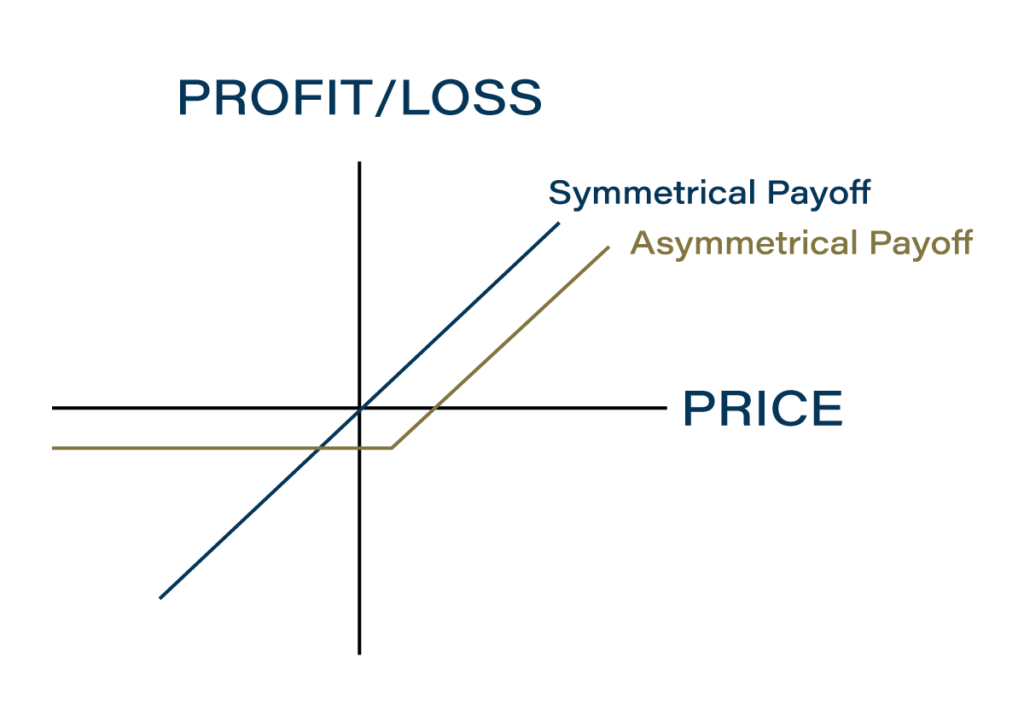How RockStep Delivers Asymmetric Returns In Retail Real Estate
When it comes to investing, there are countless approaches and methodologies that have been tried all with the same goal – high-yield returns. Investors have spent decades studying and experimenting with different techniques to maximize returns while attempting to avoid volatility and risk. The idea that higher returns are yielded from higher risks is commonplace and often true. But is it possible to make a profit on moderate or lower-risk investments? Some investors have, and it’s through a process called asymmetric investing.
What Is Asymmetric Investing?

Asymmetric investing involves investing in a property, product or business where potential gain outweighs the potential risk; the returns reflect asymmetrically balanced risk/reward profiles. Investments with asymmetric returns are less volatile and represent fewer opportunities for loss, while also delivering above-market returns. Further, on a risk-adjusted basis, the return is significantly higher than what one would expect from a normal distribution of outcomes. It is this potential for outsized profits and limited risk that entices investors to these opportunities.
Asymmetrical Returns in Real Estate
Asymmetric returns can be found across many different asset classes, but they’re particularly compelling in real estate, where many investors have found positive cash flows, namely in the commercial retail real estate market.
RockStep Capital has been delivering above-average risk-adjusted returns through its retail real estate investments for over two decades. Our average returns have been 25% IRR with a 2.1x MOIC since 1996.
25% IRR | 2.1x MOIC AVERAGE RETURNS
Considering the headwinds that malls and shopping centers have faced from the “Amazon Effect” and the implications of COVID, this track record is something we are very proud of. Investors that we meet often ask us how we have delivered these returns while having never returned an asset to a lender or required a capital call since RockStep has been in business. The answer is simple; we are patient and only invest in assets that provide an asymmetric return profile.
Asymmetric returns in real estate historically have provided the potential for significant profits with limited downside risk. This can be particularly appealing to investors who are risk-averse but still want to generate attractive returns on their investments while also benefiting from the positive cash flow of investment properties. Additionally, asymmetric returns can help to mitigate the impact of market volatility, which can be especially beneficial for long-term investors who are looking to build wealth over time.
RockStep Capital’s Investment Strategy Minimizes Downside
RockStep focuses on investment opportunities that generate strong returns where the maximum downside return is acceptable for the investment. One critical aspect of offering assets that possess asymmetric returns to our investors is understanding an asset’s potential downside. Limiting potential downside performance is part underwriting discipline and part asset selection. Adhering to our principles of underwriting is essential for delivering predictable returns to our investors.
There are several elements in a mall or power center’s evaluation that need to be understood before a property is suitable for investment. The source of the greatest downside volatility to the cash flows in a retail asset is the status of the co-tenancy provisions in the leases in the asset under evaluation.
CO-TENANCY
First, let’s understand and provide clarity around the topic of co-tenancy. A co-tenancy clause in a retail lease contract allows a tenant to reduce its rent if key tenants or a certain number of tenants vacate the retail space in question. A large or key tenant (an “anchor tenant”) is usually a big draw for traffic, especially in malls, and is often one of the major reasons a tenant or a group of tenants choose to locate in a specific asset. Co-tenancy risk is a very dangerous risk for a retail property to accept. Essentially, the landlord is taking the current and future operating risk for an anchor or a group of anchors at the property. Misunderstanding or misjudging this risk can result in the vacancy of the anchor(s) in question but also expose the asset to a group of tenants who can, at best, reduce their rent significantly or at worst, allow them to vacate upon meeting certain criteria. In either circumstance, the asset will generate a drastic reduction in cash flow at the same time as an asset is losing its competitive standing in the market (by losing its anchor).
At RockStep Capital, we refuse to accept this risk. We understand that the corporate risk of incorporating department stores, who make up the vast majority of named anchor tenants in a co-tenancy agreement, is difficult to judge and often, the landlord doesn’t have the opportunity to assess the profitability of the store. With all these unknowns, the risk is not worth it.
However, RockStep will evaluate opportunities where the co-tenancy risk has already transpired in an asset. In this case, an anchor(s) has already vacated, and the lease provisions have already allowed the affected tenants to reduce their rent or leave. This means that the asset will only generate better than underwritten cash flows because the co-tenancy in the asset has already played out.

RockStep Underwriting Principles Create Upside
A second key aspect of our underwriting that allows investors to realize asymmetric returns is our treatment of vacancy. Put simply, RockStep doesn’t “lease up” vacancies in our underwriting proformas. The result of this approach is that if we purchase an asset that has vacancies and a space becomes leased, the profit that is generated falls to the bottom line, generating positive returns for our investors. In this case, a positive outcome for a vacant space can only expose an investor to “upside” cashflows.
The last major underwriting principle that RockStep adheres to is our strict attention to investment basis. RockStep will only purchase a property that is producing enough net operating income in all scenarios to cover its operating expenses. There are many retail assets across the country that are struggling with vacancies and other issues, which creates a situation where the asset is not generating enough income to cover its monthly operating expenses. Although distressed assets often sell for pennies on the dollar, investments in properties that do not meet their monthly expense obligations may create a misalignment between the investment manager and its investors. In these situations, the “basis” or investment in the property is growing every month as the property fails to meet its monthly obligations and thus the investor must add to its investment to keep the property afloat. Meanwhile, the investment manager may be forced to make decisions that are better for the short-term rather than the long-term health of the asset. RockStep Capital avoids this issue by only considering those assets that produce enough stable cash flow to meet its monthly obligations. This rule allows the basis of the Company’s assets to stay as low as possible, allowing an eventual sale of the property to generate only upside scenarios.
Asset Selection Keys Asymmetric Returns
Equally as important as our underwriting methodology in creating asymmetric returns for our investors, adherence to asset selection criteria also drastically reduces the risk for the investor in retail real estate investments.
RockStep Capital will only consider investing in properties that possess some of the
following characteristics:
KEY ASSET SELECTION CRITERIA
Top 35
MSA
In-Fill
Locations
State of the Art
Transportation
Strong Demand Drivers
Division I, II, III Universities
Major Government/Military Installations
Strong Tourism
250 Hospital Networks
Fortune 1,000 Companies
If an asset possesses many of these requirements, the property will generally be immune to economic downturns that will create worse-than-downside scenarios for the investor.
Redevelopment & Repositioning Creates Asymmetric Return Opportunities

When it comes to real estate investing, the retail sector, which includes properties such as shopping malls, outlet malls and power centers, has provided compelling opportunities for asymmetric returns. While the retail sector can be challenging to navigate with shifting consumer preferences, evolving retail trends and the rise of e-commerce, it has also provided attractive opportunities for investors who are willing to take on marginal risk in exchange for the potential for outsized returns.
Another one of the keys to achieving asymmetric returns in retail real estate? The ability to identify properties that are undervalued or underperforming, and then take steps to improve their value.

Value-Add Strategies in Retail Real Estate
Value-add strategies involve finding properties that are underperforming or undervalued and making improvements that increase their worth. In retail real estate, value-add strategies can take many different forms, but one of the most successful is retail repositioning.
Repositioning involves altering the use of a property to make it more profitable and to better meet the needs of a community. For example, a retail property that is not generating sufficient operating income might be converted into a mixed-use development with residential or office space. This can help to increase the property’s value and generate higher returns for investors, while simultaneously attracting more people to the retail spaces that still exist there.
Repositioning functions to increase asymmetric returns, further lowering risk, and increasing the potential for cash flow and adding value to the community and the asset.
Because of this, RockStep Capital has been delivering asymmetric returns to its investors for over 25 years. Although the retail landscape is challenging, we feel that our disciplined underwriting and asset selection methodology coupled with our repositioning strategies not only reduces risk but allows Rockstep to offer return profiles that expose our investors to upside scenarios that are far greater than potential downside scenarios. It is through this investment thesis that RockStep Capital has been able to outperform other retail investment managers without exposing our investors to significant risk.